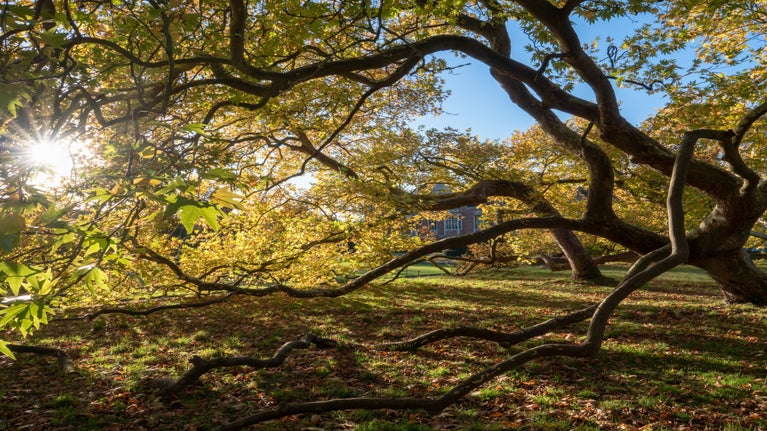
Trees and plants
We care for 25,000 hectares (61,776 acres) of woodland, 135 wild landscape sites and more than 200 gardens, and have as many wonderful stories to tell.

Every year in springtime, bluebells transform woodland floors across the country into a delicate sea of blue. Learn about the types of bluebell you'll find in the UK, how to tell them apart and how this captivating little flower has long inspired writers, storytellers and even medical researchers.
The bluebell has held a treasured place in the hearts of British people for centuries. It's been an inspiration to poets and writers such as Oscar Wilde, Emily and Anne Brontë, Gerard Manley Hopkins and Percy Bysshe Shelley.
This delicate wild flower has played an influential role in folk culture too, and some of the names it's been given offer an insight. For instance, the earliest British botanists called them crowtoes, but they’ve also been called cuckoo’s boots, wood hyacinth, lady’s nightcap and witches’ thimbles.
Many myths surround the bluebell, although for such a heart-lifting flower the folklore is rather gloomy. There was a belief that bluebells were used in witches’ potions. Others believed that anyone who wanders into a ring of bluebells will fall under fairy enchantment, or that anyone who hears the ringing of the flower’s bell will be visited by a malicious fairy and die soon after.

We owe the British bluebell more than myth and sentiment, as it has also had practical uses throughout the ages.
The bluebell’s bulb contains muselage and inulin which was used as a glue for fixing feathers and arrows and for bookbinding. The Elizabethans used the starch-like juice from the bluebell bulb to stiffen their fancy ruff collars.
Bluebells were not often used medicinally but legend has it that they were used by 13th-century monks to treat snakebites and leprosy – something of a kill-or-cure remedy given that the bulb is poisonous.
On the other hand, present-day researchers are looking into the bluebell’s highly effective animal and insect repellent properties. There’s even the possibility that certain bluebell extracts could be used to combat HIV and cancer.
Hyacinthoides non-scripta bluebells are native to the UK but they’re under threat from the non-native Spanish bluebell (Hyacinthoides hispanica) which was introduced to Britain around the late 17th century. In the last 30 years the Spanish bluebell has escaped from gardens and has begun to mix with the native species.
It’s fairly easy to tell the difference between English and Spanish bluebells but the hybrids can be trickier as they take characteristics from both.
The individual bells of the native bluebell are narrow with straight sides and have petals which curl back at the edges. The stem is curved, with most of the bells hanging to one side.
The bells of Spanish bluebells are more cone-shaped and their petals tend to flare rather than curl back. The stems are more upright, with bells hanging all round.
Look at the pollen inside the flower. If it's creamy-white then the bluebell is probably native (or a hybrid). If the pollen is green or blue, it's not native.
Native bluebells are usually a deep blue-violet shade, while Spanish ones tend to be paler. Confusingly, both varieties can also come in white and pink.
Native bluebells have a strong, sweet scent, which makes the woods smell amazing on a warm day. The Spanish variety has little to no scent.
Native bluebells have relatively narrow leaves, around 1–1.5cm wide. Spanish and hybrid bluebells tend to have much bigger leaves, around 3cm wide.

We care for 25,000 hectares (61,776 acres) of woodland, 135 wild landscape sites and more than 200 gardens, and have as many wonderful stories to tell.
Discover some of the best places to see bluebells in the UK, including paths through ancient woodlands, walks in lush valleys and trails around nature reserves.

Find out how we work to look after the UK’s bluebell population and what you can do to help us protect this much-loved wild flower.

The bluebell is one of the nation's favourite wild flowers and our gardeners take great care of these plants at many of the places we look after. Discover some of their top tips for growing bluebells in your garden.

Discover the stories behind some famous British wild flowers and how wildflower meadows support important species from butterflies to bees.

Our woods have been used in many ways since the Ice Age, from royal hunting grounds to military bases. Spot clues to past lives hidden in your favourite woodland.

Learn about forest bathing, a way of relaxing and slowing down the mind by immersing yourself in nature. It can help reduce blood pressure, lower stress levels and improve concentration.

Discover the history behind the daffodil, including how it came to be one of the UK's favourite flowers, where it came from and how to classify its many varieties.

Tulips have been a popular flower for centuries. Find out where they came from, how they inspired the 'tulipmania' craze and learn about the different varieties you can still spot today.
